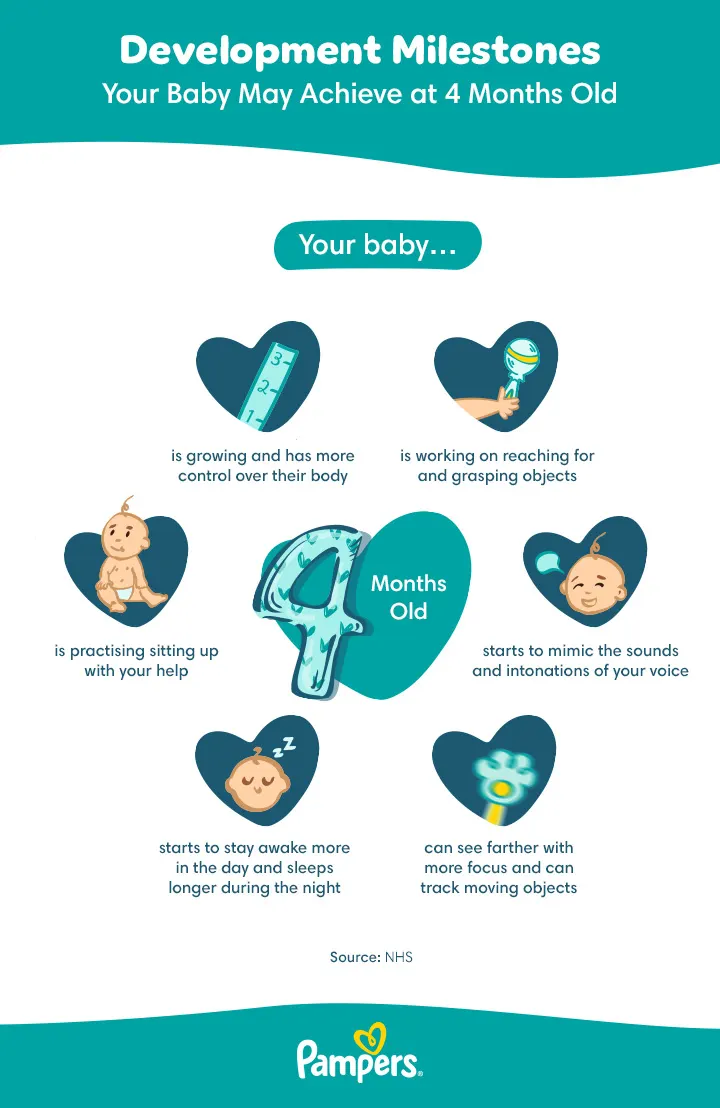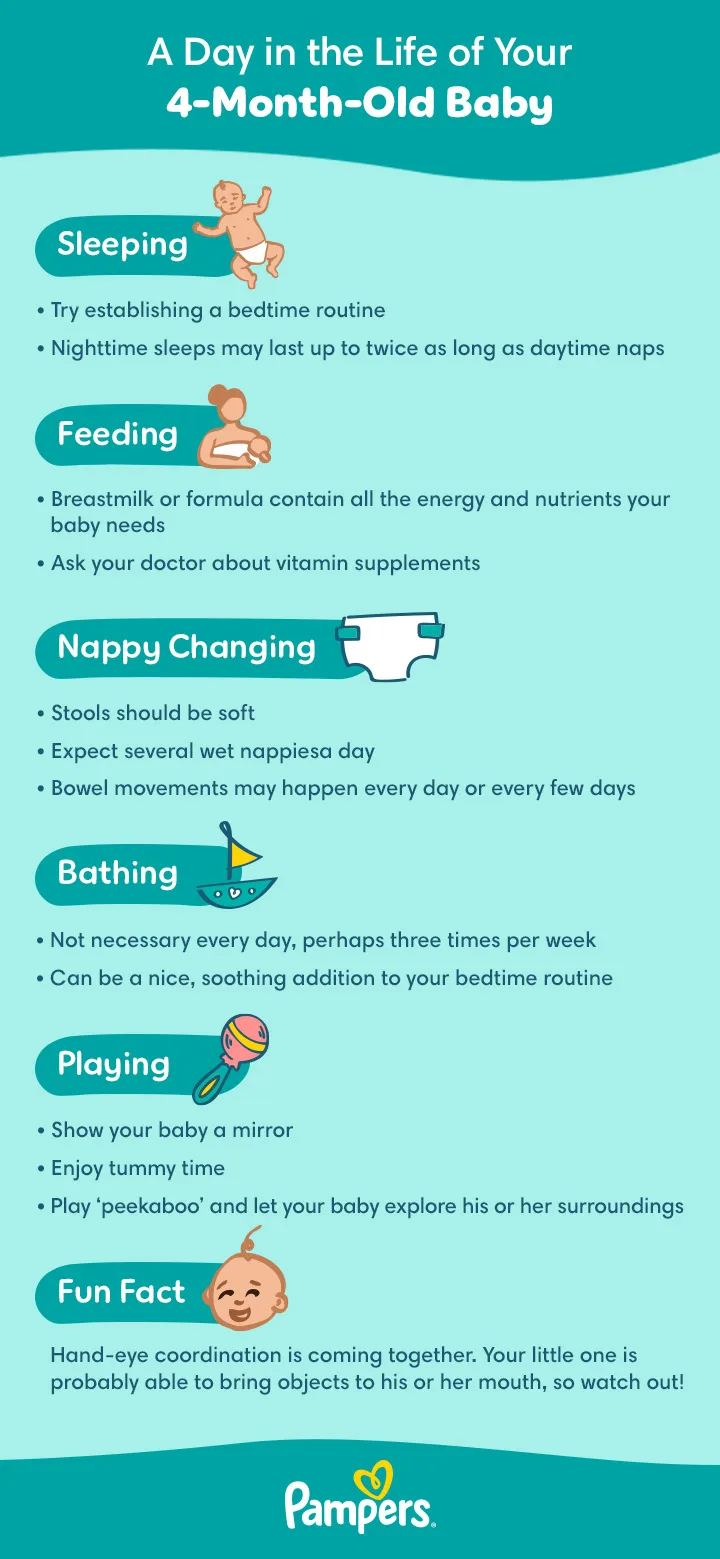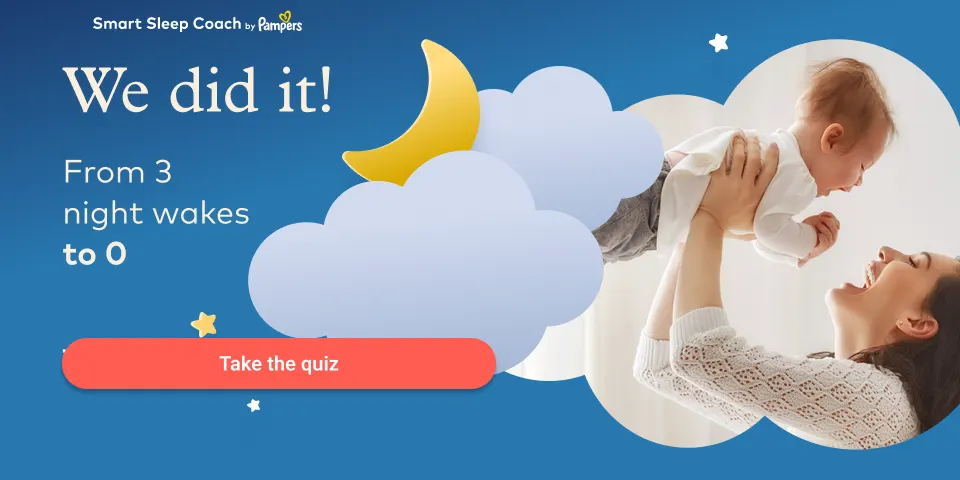Your 4-Month-Old Baby’s Development and Milestones
At four months old, your baby is entering an exciting stage of development. You’ll likely notice more smiles, growing curiosity and stronger movements as they start interacting more with you and the world around them. If you’re wondering what a 4-month-old baby might be doing at this stage, here are some common milestones:
- Motor skills. Holds their head up, pushes up during tummy time, brings hands to mouth and may begin to roll from tummy to back.
- Cognitive and sensory. Watches faces, explores hands and fingers, follows moving objects and starts recognising familiar people.
- Communication. Coos, babbles (like ‘ahh’ or ‘ba’), smiles socially and turns toward voices.
- Feeding. Breast milk and/or formula remain the only nutrition needed. Your little one may become more distractible during a feeding around this age.
- Nappying. Around six to eight wet nappies a day, with soft poo, even if not daily.
- Sleep. Needs 12–16 hours of sleep in 24 hours, including night-time stretches and two to three daytime naps.
- Health. Time for the 4-month check-up and vaccinations, including the third dose of the 6-in-1 vaccine and the second dose of the MenB vaccine.
Every baby develops at their own pace, but knowing what’s typical at this age can offer reassurance – and help you spot when it might be time to check in with your GP or health visitor . In this guide, we’ll take you through what to expect at four months, along with tips for supporting your baby’s development, feeding, sleep and routine.
Baby Development Milestones
Now that your baby is four months old, daily life may feel more settled as routines begin to take shape, yet your 4-month-old baby will keep you on your toes, and that’s perfectly normal.
At this stage, your little one is honing their motor skills. You may see them reaching for a favourite toy, pushing up onto their forearms during tummy time, or even attempting to roll over. Some parents spot their baby sitting briefly with support or bearing a little weight on their legs when held upright. These early movements lay the groundwork for future coordination, strength and confidence as they explore the world around them.
Physical Development: Average Weight and Length of a 4-Month-Old
A 4-month-old’s weight may have rapidly increased on their growth chart, though exact figures vary from child to child. From 2 weeks up to 6 months of age, babies should be weighed once a month. This schedule helps avoid unnecessary worry over small fluctuations and gives a clearer picture of true growth over time.
Your 4-month-old baby is likely continuing to grow at a rapid pace. Your GP will track that growth in your baby’s red book on centile charts, which show the pattern of growth followed by healthy children. There are different growth charts for boys and girls.
The curved centile lines on the charts indicate the average height and weight gain for babies. Your baby’s growth measurements will be plotted on these charts. This way, you will be able to see how your baby compares with others of the same age and gender in terms of growth, just by looking at the charts.
The focus is on long-term trends, rather than achieving a single target. Also, don't be surprised if you notice signs of a 4-month growth spurt, such as fussiness or brief sleep disruptions; these are completely normal and usually pass within a few days. Growth spurts are a natural part of development as your little one’s bones, muscles and fat stores continue forming. They’re influenced mainly by genetics, but things like diet, environmental factors and pregnancy health may also play a role in how and when your baby grows.
Movement: Gross and Fine Motor Skills 4-Month-Olds Develop
By this time, you may notice your baby’s gross motor skills at 4 months old have really improved. You may see them lift and hold their head steady during tummy time and push up onto their forearms to look around. In a supported sitting position, they’ll keep their head level and might even lean forward to reach for a favourite toy, showing off their key 4-month gross motor milestones that lead to rolling and independent sitting in the months ahead.
Here’s a quick look at what motor skills a 4-month-old should have or be working toward:
- Head control. Lifts and holds their head steady when on their tummy.
- Upper-body strength. Pushes up on forearms during tummy time.
- Supported sitting. Keeps their head level and leans forward to reach for objects.
- Hand coordination. Brings hands together, touches fingers and grasps toys.
- Object exploration. Waves and mouth toys, practising hand-to-mouth movement.
These fine motor skills and gross movements, which form the foundation for rolling, sitting and crawling in the coming months, are each a significant step forward in your baby’s journey of discovery.
Cognitive Development and Eyesight of a 4-Month-Old
The world around your baby is coming into focus, literally, as their distance vision steadily improves. Your little one may start to recognise you and other familiar faces at a distance, and can probably easily follow moving objects with their eyes from side to side.
Another source of endless visual fascination for your 4-month-old baby? Themselves! An unbreakable mirror is a great toy for infants at this age, allowing them to see their own movements reflected back at them.
The foundations of your 4-month-old baby’s language skills are forming, thanks to improved hearing and cognitive development. Your little one may be able to mimic some of the rhythms, tones and patterns of some of the words you speak to them, and their cries may sound different based on their various needs. It may all sound like baby babble now, but this is helping to build a solid foundation for later speech.
Want to learn more about their speech? Check out our guide on when babies start talking.
Every baby progresses at their own pace, so if you have any concerns about your baby’s vision or emerging communication, consult your GP or health visitor for personalised advice.
Behavioural Changes in a 4-Month-Old
Around four months, you may notice your little one becoming more easily distracted – feeds that once lasted half an hour may shorten as they turn to look at new sights and sounds, and a spell of extra fussiness can set in as they process all those big developmental leaps.
Sleep often shifts at the same time: babies who previously enjoyed longer stretches may start waking more frequently or napping for shorter periods, reflecting the rapid brain growth and lighter sleep cycles that occur during this stage.
Although this ‘four-month fussiness’ can feel challenging, it usually passes within a couple of weeks. If you’re concerned that your little one’s behaviour or sleep changes are more than a normal developmental phase, your GP or health visitor can offer reassurance and personalised advice.
Your baby is growing every day! See how far they’ve come and what’s next with our Growth Chart Calculator.
Activities & Development Tips for Supporting Your 4-Month-Old
Looking for ideas on what to do with a 4-month-old and how to support your baby’s development? At this stage, your little one is becoming more aware, social and curious, making it a great time to explore simple ways to play and connect as they develop. Whether you’re building routines or seeking fresh inspiration, here are some engaging daily activities for a 4-month-old that also promote growth.
- Tummy time. Lie your baby on a soft blanket or your chest for a few minutes each day, gradually increasing the time as they grow more comfortable. This builds neck, back and shoulder strength and offers a fresh view of their world.
- Chat and sing. Describe what you’re doing, sing nursery rhymes or recite poems during feeds and nappy changes. Mirroring your baby’s coos and babbles encourages early communication and emotional bonding.
- Mirror exploration. Place an unbreakable mirror at floor level so your little one can watch their reflection. Seeing themselves move supports visual tracking, self-awareness and curiosity.
- Grasp and reach. Offer safe items, such as a wooden spoon or soft cloth, to hold and put in the mouth. During supported sitting, dangle a rattle just out of reach to prompt reaching and balance, strengthening fine motor skills and coordination.
- Gentle massage. After a warm bath or before a nap, spend a few minutes massaging your baby’s arms, legs and back to soothe tense muscles and promote body awareness.
Always follow your baby’s cues; if they look away or become unsettled, give them a break. These responsive interactions build trust, support healthy development and strengthen your bond. If you’d like more activity ideas or reassurance, your GP or health visitor can offer personalised suggestions.
What ‘Should’ a 4-Month-Old Be Doing?
Your baby's budding curiosity and alertness make every day special and you're likely feeling more at ease as you settle into a routine with some simple daily tasks. Here is an example of a daily schedule for a 4-month-old, which you could follow:
This day-in-the-life view can help set expectations, but remember, routines will vary from baby to baby. Focus on progress, not perfection and consult your baby’s GP or health visitor if you have any concerns.
How Much and How Often Should a 4-Month-Old Eat?
At four months, your little one still gets all their nutrition from breast milk, formula or a combination of the two. Weaning should not begin before around six months, as your little one isn’t developmentally ready to swallow or digest solids.
Offer feeds on demand, watching for early hunger cues, licking their lips, stirring in sleep, sucking on hands or rooting (turning their head towards your breast or bottle).
If you’re ever unsure whether your baby is feeding well or if feeding patterns change suddenly, your GP or health visitor can advise on feeding technique and reassure you that your baby is thriving.
Teething
Although most babies’ first teeth appear around 6 months, some begin teething as early as four months. Early signs of a 4-month-old teething baby include increased dribbling, chewing on fingers or toys, flushed cheeks and mild irritability.
There are ways to help soothe your little one’s sore gums, such as offering a gently chilled teething ring or a clean flannel cooled under running water. You can also massage their gums with a clean finger. Avoid teething gels unless specifically recommended by your GP or pharmacist. If you’re unsure whether your baby’s discomfort is due to teething or another issue, your GP or health visitor can help determine the cause and suggest further relief.
Nappy Changes at 4 Months Old
Change your baby’s nappy as soon as they’ve wee or pooed to keep skin comfortable and help prevent nappy rash. Four-month-olds typically need six to eight changes per day. Expect soft, mustard-yellow stools in breastfed babies and slightly firmer but still soft stools in formula-fed babies. Even if your little one doesn’t poo every day, they’re not constipated as long as the consistency remains soft. If you notice hard, pellet-like stools, blood in the nappy or other worrying signs, your GP or health visitor can advise you on the best next steps.
How Much Should a 4-Month-Old Baby Sleep?
By four months, many babies settle into two to three daytime naps, with shorter awake windows in between and begin to extend their overnight sleep. Some little ones may even manage five to eight hours at a stretch without a feed, though every baby varies.
You may notice a temporary shift in sleep patterns around this age, often referred to as the 4-month sleep regression, which can be challenging but typically passes within a few weeks. A simple, consistent bedtime routine – perhaps a warm bath, gentle massage, winding down with a quiet feed and a lullaby – helps signal that it’s time for sleep.
If you’re wondering how much sleep a 4-month-old should get, remember these are guides rather than strict rules. Your GP or health visitor can offer tailored advice if your baby’s sleep pattern raises any concerns.
Sleep patterns can change a lot around 4 months — you’re not alone!
Take our short quiz for tips on improving sleep for both of you.
Your Baby's Health
At 4 months, your baby may seem more alert and active, but it’s also a time when many parents start navigating minor illnesses or developmental health checks. Whether your baby is dealing with a stuffy nose or heading in for a 4-month checkup, here’s what to know:
- Fever. In babies under six months, a temperature of 38 °C or higher is classed as a fever and often signals infection. Your baby may have flushed cheeks, clammy skin or feel unusually warm. Fever can follow viral illnesses, such as colds or ear infections and may also appear after vaccinations. Use a digital thermometer under the armpit and follow the manufacturer’s instructions. If your baby’s fever lasts more than five days, doesn’t improve with infant paracetamol or ibuprofen or they show signs of dehydration, contact your GP promptly.
- Colds and common illnesses. A cold is an upper respiratory infection caused by a virus. Colds are very common (babies might have 8 or more colds a year) and usually get better in about a week or two. Infant paracetamol or ibuprofen, or saline nose drops may be a great help in relieving symptoms, which may include a runny nose, sneezing, mild fever, cough, low appetite or a sore throat. Check with your GP first to determine the best treatment for your baby.
- Bronchiolitis. Another common viral illness is bronchiolitis, which is an infection and inflammation of the smallest airways in the lungs. It's highly contagious, so be especially vigilant about hand-washing during winter, when infections are more likely to spread. Early symptoms, such as a runny nose and cough, are similar to the common cold. Bronchiolitis typically resolves within two to three weeks without requiring specific treatment.
Contact your GP or call NHS Direct right away if your baby
- is breathing noisily
- has a persistent fever
- has cold hands or feet.
The 4-Month Check-up and Vaccinations
At your baby’s 4-month check-up, your GP or health visitor will check their growth, review developmental milestones and answer any questions you may have about feeding, sleep or behaviour.
Your little one will also receive the following 4-month vaccinations:
- 6-in-1 vaccine (3rd dose) – protects against diphtheria, tetanus, whooping cough, polio, Hib and hepatitis B
- MenB vaccine (2nd dose) – protects against meningitis B.
Mild side effects, like a low-grade fever or fussiness, are common after these 4-month-old immunisations. Infant paracetamol may help if needed. If you’re unsure about anything after the 4-month check-up, your GP or health visitor is there to support you.
4-Month-old Milestones Checklist
Every baby develops in their own time, but here are some common 4-month-old baby milestones you might start noticing around now. Use this checklist as a guide to celebrate your little one’s progress and support their development:
- Holds head steady when upright or during tummy time
- Pushes up onto elbows during tummy time
- Brings hands together and explores fingers or toys
- May start to roll from tummy to back
- Babbles or coos in response to voices
- Turns head toward voices or sounds
- Tracks moving objects with eyes
- Smiles and recognises familiar faces
- Shows signs of hunger or fullness
- May show early signs of teething (drooling, chewing).
If you’re unsure whether your baby is meeting expected milestones or seems to be progressing differently, speak to your GP or health visitor. They can help you understand what’s typical and what kind of support might be helpful.
To Do’s and Items You’ll Need This Month
- Book and attend your baby’s 4-month check-up to discuss upcoming vaccines.
- Note down any questions about feeding, sleep or development to discuss during the visit—especially if your baby’s had symptoms like fever, vomiting or rash.
- Curious about what’s ahead? Check out our 5-month milestone.
- Keep essentials stocked: nappies, wipes, nappy cream and a digital thermometer.
- Add a soft play mat, a few baby books and some engaging toys to support the growth of a 4-month-old baby.
FAQS AT A GLANCE
Not yet. Experts recommend waiting until around six months before starting solids, as your baby’s digestive system and coordination need more time to develop.
The Bottom Line
At four months, your little one is becoming more curious, expressive and responsive, turning everyday routines into moments of connection. From playful coos to stronger movements and longer stretches of sleep, this stage is full of discovery for both of you.
It’s also normal to ask what a 4-month-old should be doing. The truth is that every baby develops at their own pace. What matters most is progress, not perfection. Keep an eye on your little one’s cues, and if you ever feel unsure, your GP or health visitor is there to help.
Small moments, like tummy time, a cuddle after a feed or a quiet story, make a big difference in your baby’s growth. And don’t forget to look after yourself, too.
Want to save on nappies and wipes as you go? Download the Pampers Club App to earn Pampers cash every time you shop.
How We Wrote This Article
The information in this article is based on expert advice found in trusted medical and government sources, such as the National Health Service (NHS). You can find a full list of sources used for this article below. The content on this page should not replace professional medical advice. Always consult medical professionals for full diagnosis and treatment.






